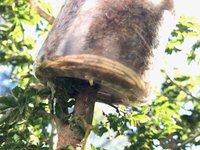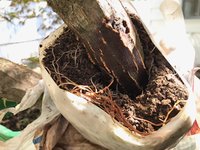SexyGArdener
Sapling


I started this in early April in 70% soil conditioner (mini pink bark and sand) and 30% crushed granite (3/8" size) in a clear snack cup uncovered. It gets water when the medium seems dry so every other day. This was done on a weak Shishigashira after severe root pruning/reduction (~75%) in March when the leaves were half-pushed and zero growth so far this year. It was foolish to repot that late, but the nursery soil wasn't draining well. I attempted 3 air-layers as backup from branches that were going to be prune anyways. I already sever 2 already; 1 seems to be doing fine and the other is struggling. I figured this one didn't have enough roots by August so I removed the soil medium (pine bark and crushed granite) and used 100% sphagnum moss around August 30th. Roots shown above are current as of today (10/23) and about 50% more since switching to Sphagnum moss. I'm going to leave this on until Spring and see how it goes.

This was removed around late August and seemed to be thriving. Roots are still not well developed, I could tell by wiggling it every couple of weeks (not smart but I have to know). Potted in 30% lava, 30% pumice, 25% turface, 10% pine bark, and 5% crush granite as a drainage layer.



These air layers are dissectum of unknow varietal (maybe Orangeola), started in mid-June because I was asked by a family member to do so because the main tree is too established to be moved and the air layers will be used as landscaping trees. The soil medium is 100% garden soil in milk/water gallon jugs. I forgot all about them until yesterday and decided to check because I was told dissectums were notoriously difficult to air-layer so I assume they won't have adequate roots until next spring considering how late they were started. I'm going to leave these on because they're wrist thick, 3 foot tall and wide each, and I have no room to over-winter these. The parent tree has always been neglected, no water or fertilizer. I'm excited to see if they survive this winter and if they'll thrive next year. The plan is to plant them in 15 gallon pots in the spring and ground plant them in the fall.

